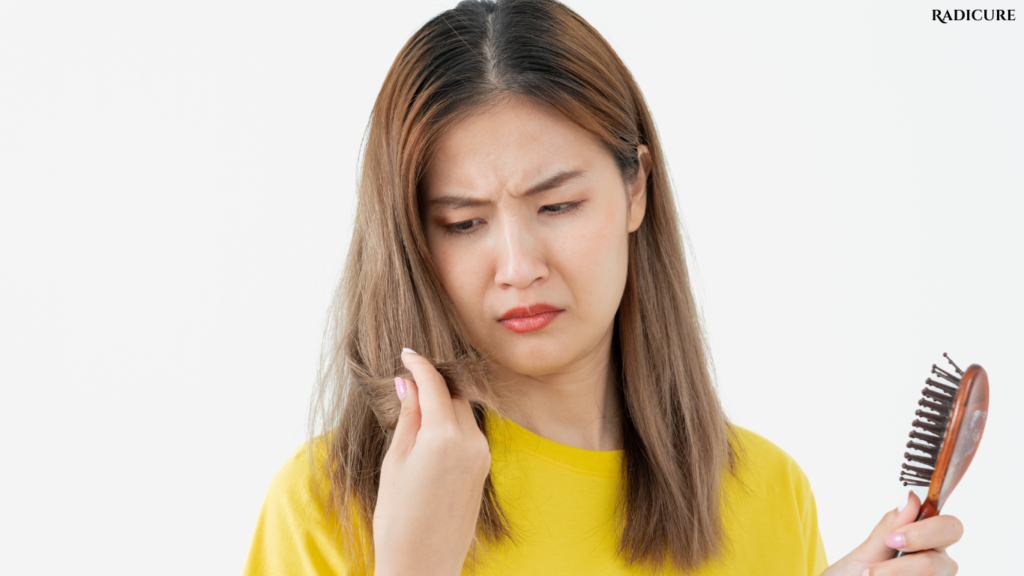How to Prevent Hair Breakage: Effective Tips for Stronger, Healthier Hair
How to Prevent Hair Breakage is a common issue affecting people of all hair types and lengths. It occurs when hair strands weaken and become brittle, leading to split ends, thinning, and stunted growth. Several factors contribute to hair breakage, including excessive heat styling, chemical treatments, inadequate moisture, poor hair care habits, and environmental stressors.
If left unaddressed, hair breakage can significantly impact hair health and appearance. However, with the right approach, you can minimize breakage, strengthen your hair, and promote healthy growth.
This guide outlines the causes of hair breakage and provides 12 effective strategies to prevent and treat it.

Image credited by canva
Causes of Hair Breakage
Understanding the root causes of How to Prevent Hair Breakage is essential for maintaining healthy hair. Common causes include:
- Lack of Moisture: Dry hair is fragile and more prone to breakage.
- Excessive Heat Styling: Frequent use of heat tools weakens the hair shaft.
- Over washing: Shampooing too often strips hair of natural oils, leading to dryness.
- Tight Hairstyles: Continuously wearing tight ponytails, buns, or braids creates tension and weakens hair strands.
- Chemical Damage: Hair coloring, perming, and relaxing treatments weaken hair proteins, making strands susceptible to breakage.
- Poor Diet: A lack of essential nutrients, such as protein, biotin, and omega-3 fatty acids, results in weaker hair.
- Rough Towel Drying: Rubbing hair vigorously with a towel causes friction and breakage.
- Wrong Hair Products: Harsh shampoos and alcohol-based styling products strip hair of natural oils and damage the cuticle.
Now that you know the causes, let’s explore the best ways How to prevent hair breakage and maintain strong, healthy hair.
1. Keep Your Hair Hydrated
Moisture is crucial for hair strength and elasticity. To maintain hydration:
- Use a sulfate-free shampoo to retain moisture.
- Apply a deep conditioning treatment once a week.
- Use leave-in conditioners or hair serums to lock in moisture.
- Avoid washing hair with hot water, as it strips natural oils.
2. Minimize Heat Styling
Excessive heat can damage your hair’s protein structure. Reduce heat damage by:
- Air-drying hair whenever possible.
- Using heat protectant sprays before styling.
- Keeping heat tools at a low to medium temperature.
- Limiting curling irons, straighteners, and blow dryers to once or twice a week.
3. Avoid Over washing
Frequent washing strips natural oils and causes dryness. Follow these tips:
- Wash hair 2-3 times a week instead of daily.
- Use a moisturizing shampoo and conditioner.
- If your scalp becomes oily, use dry shampoo instead of frequent washes.
4. Use a Wide-Tooth Comb
Detangling hair roughly can lead to breakage. Instead:
- Use a wide-tooth comb on wet hair to prevent pulling.
- Start detangling from the ends and move upward.
- Apply a detangling spray for easier combing.
5. Trim Split Ends Regularly
Split ends weaken hair and lead to breakage. Prevent this by:
- Getting a trim every 6-8 weeks to remove damaged ends.
- Using sharp hair-cutting scissors instead of blunt ones.
6. Protect Hair While Sleeping
Friction while sleeping can cause breakage. To protect your hair:
- Use a silk or satin pillowcase.
- Tie hair in a loose braid or use a silk scarf.
- Avoid sleeping with wet hair, as it is more vulnerable to breakage.
7. Avoid Chemical Over Processing
Chemical treatments weaken hair over time. Reduce damage by:
- Choosing ammonia-free or natural hair dyes.
- Spacing chemical treatments at least eight weeks apart.
- Using bond-repair treatments to strengthen chemically treated hair.
8. Maintain a Hair-Healthy Diet
Diet plays a crucial role in hair strength. Include:
- Protein-rich foods such as eggs, fish, and nuts.
- Biotin and vitamin E sources like avocados and almonds.
- Omega-3 fatty acids from salmon, flaxseeds, and walnuts.
- Leafy greens like spinach for iron and folic acid.
9. Limit Tight Hairstyles
Tight hairstyles pull on hair strands, leading to breakage. To prevent this:
- Opt for looser styles.
- Use fabric-covered hair ties instead of elastic bands.
- Change hairstyles frequently to prevent tension in one area.
10. Avoid Excessive Towel Drying
Rubbing hair with a towel causes friction and breakage. Instead:
- Pat hair dry with a microfiber towel.
- Use a soft cotton T-shirt to remove excess water.
- Let hair air-dry naturally whenever possible.
11. Use Hair Masks and Natural Oils
Applying hair masks and oils regularly can help repair damage. Recommended treatments include:
- Coconut oil for deep conditioning.
- Argan oil for shine and moisture.
- Castor oil to promote hair growth.
- Aloe Vera masks to soothe and strengthen hair.
12. Reduce Stress Levels
High stress can contribute to hair breakage and hair loss. Manage stress by:
- Practicing yoga and meditation.
- Ensuring 7-8 hours of sleep each night.
- Engaging in relaxing activities such as reading or walking.
The takeaway
How to Prevent Hair Breakage requires consistent hair care, a balanced diet, and healthy styling habits. By following these 12 effective tips, you can strengthen your hair, minimize breakage, and promote overall hair health. Small changes in your routine can lead to significant improvements. Start incorporating these tips today for stronger, shinier, and breakage-free hair.
